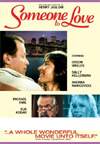Someone To Love
Paramount Home Video
Cast: Orson Welles, Henry Jaglom, Andrea Marcovicci, Sally Kellerman
Extras: Commentary Track
Rating:
Director Henry Jaglom's unconventional and experimental style of filmmaking has not made him an audience or critical favorite, but he has carved out a unique niche on the independent film scene. His highly personal and sincere projects reveal a deeply thoughtful man who seems more concerned with expressing his thoughts on film than with furthering the visual possibilities of the cinema. It is not difficult to see why his films can be so easily dismissed. That said, "Someone to Love" is a surprisingly accessible film, in spite of its metacinematic qualities. An exploration of relationships in the post-sexual revolution era, the movie is alternately funny, heart-breaking, revealing, and powerful in its largely improvised structure.
On Valentine's Day, movie director Danny Sapir (Henry Jaglom) invites a group of single friends and acquaintances to an abandoned theater, supposedly for a party. When they arrive, he reveals to them that he has hired a film crew to document the party as he interviews each person, probing why he or she is not in a relationship. Over the course of this experiment, the guests offer candid revelations of their views on romance, question why they have been gathered together, and even break down as they become wrapped up in the dark truths that are uncovered. While the guests interact, the constantly running cameras pick up their most private and naked moments as they address the state of their lives and find out more about the people around them.
As with most of his films, Jaglom gathered a cast of friends and professional acquaintances to portray thinly veiled portraits of themselves. His then-girlfriend Andrea Marcovicci plays Danny's lover in the film, frustrated by her desire to remain independent while still wanting a relationship. Sally Kellerman is Edith Helm, an aging actress who finds that her star is slowly fading. Michael Emil, Jaglom's real-life brother, plays Danny's socially inept brother who owns the theater and has signed a deal to have it torn down. Other personalities are sprinkled through the cast, such as musician Stephen Bishop and singer/actress Ronee Blakley, but the most interesting one is Orson Welles, who apparently plays himself. In his last film appearance (the movie is dedicated to him), Welles offers his personal insights on love and relationships in the late 20th century, and he provides some of the movie's best moments.
While the film was partially scripted, the bulk of it seems to have been improvised by the actors (and non-actors) or made up by Jaglom as the filming progressed. The film-within-a-film style allows for an effective blurring of reality and fiction, and indeed it is extremely hard to figure out exactly what is real and what isn't. The cinematography has all of the artlessness of a behind-the-scenes documentary, and the editing is choppy, conveying a manic and disorienting sense to the viewer. It almost seems to have as much to say about our expectations of what a film should be as it does about relationships. The ending of the film feels a bit forced and overly Brechtian, as Welles and Jaglom have an onscreen argument about how to end the movie, but Welles' apparently unscripted laughter makes it fun nonetheless.
The film is presented by Paramount Home Video in a 1.85:1 anamorphic widescreen transfer that looks very good, considering its low-budget status. The image is sharp and smooth, with deep black levels and fine contrast. Due to the low lighting and what I guess could be called guerilla techniques, the movie has a dark and grimy appearance that is a deliberate and appropriate element. There is some grain throughout, and skin tones are on the reddish side. Overall, this is probably the best the film will look on DVD.
Audio comes by way of a Dolby Digital 2.0 mono soundtrack. Like the picture, the sound is by no means the polished work of a Hollywood film, so the mono track serves it well. The film is driven by dialogue, with no background score. There are some occasional musical scenes as characters play the piano or the guitar and sing, and they sound quite natural. Anything beyond a mono soundtrack would probably clash with the movie's rough feel.
Henry Jaglom and actress Andrea Marcovicci sit down for a very nice audio commentary. Unlike Jaglom's commentary on Paramount's "Tracks" DVD, this one retains steam with few lags and offers some fascinating insight into the film. Jaglom and Marcovicci display wonderful chemistry as they help discern which moments were scripted and which were genuine. They also provide lots of information on the little-known actors in the film. It is great fun to hear about Jaglom's relationship with Orson Welles, who died shortly after making this film. This is definitely well worth a listen.
While Henry Jaglom's films can be alienating, "Someone to Love" has just the right touch of sincerity to draw in its audience and hold them along for the ride. It is probably one of the deepest explorations of human relationships you will find in the cinema outside of a Woody Allen movie. The arresting approach makes watching this a constantly surprising experience, and it will leave you with plenty to think about after the final credits roll. Speaking of which, make sure you sit through the credits. You surely will not be disappointed if you stick around.







